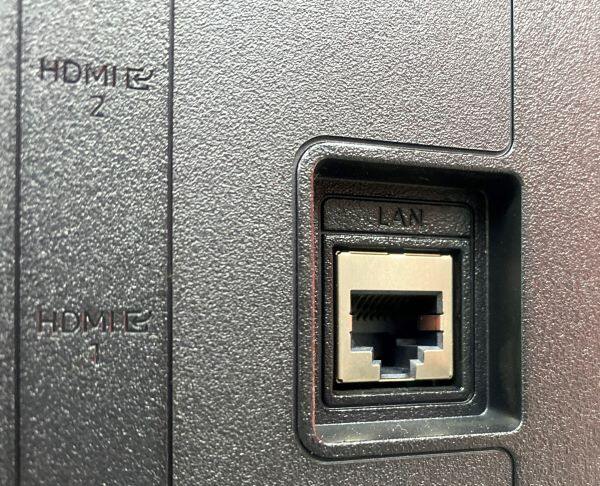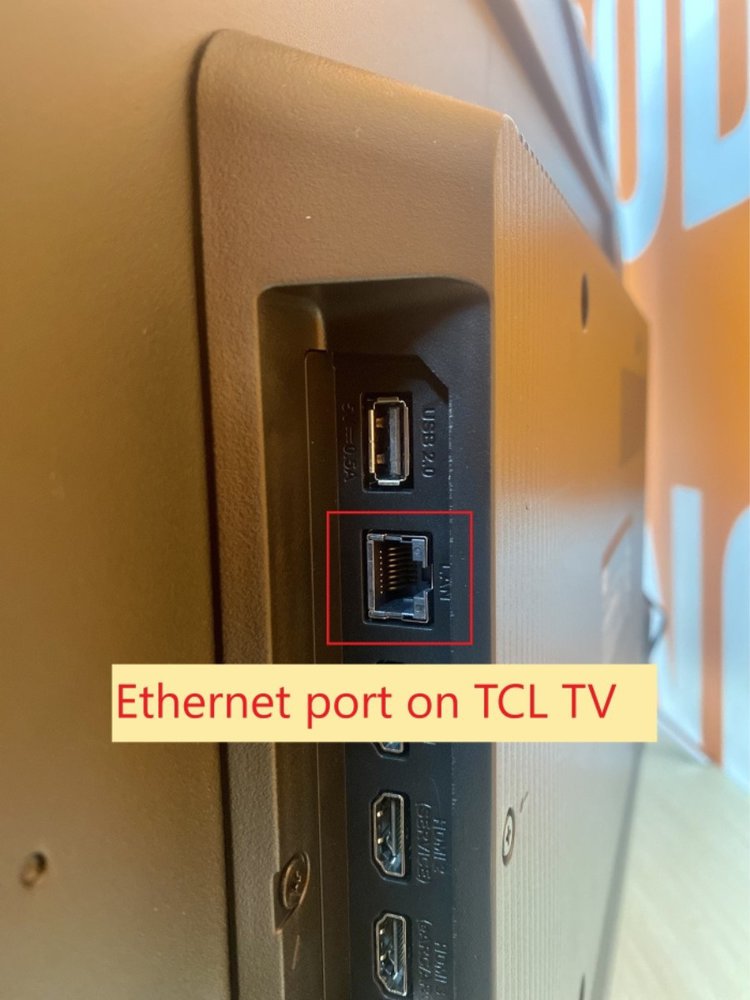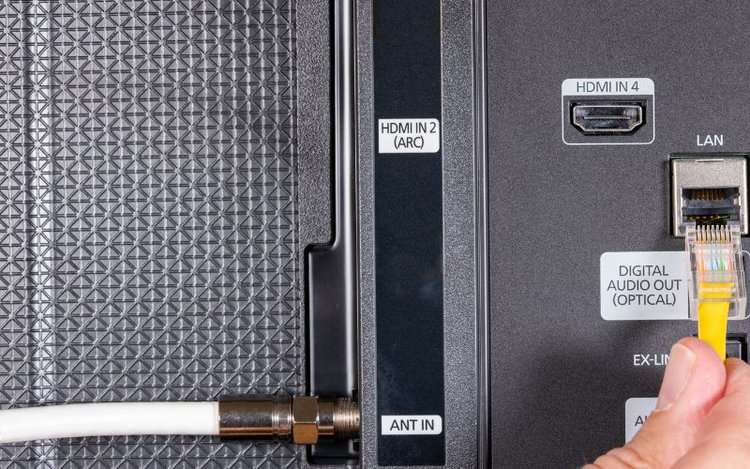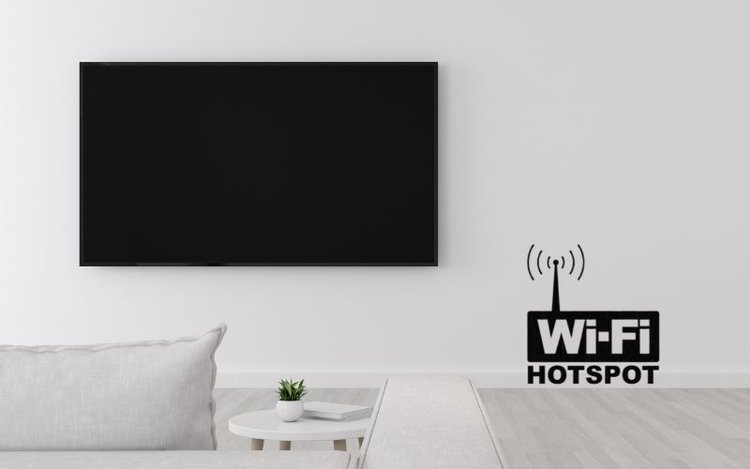TV with Ethernet Port Missing? We’ve Got You Covered

What To Know
- Only smart TVs typically have Ethernet ports to facilitate internet connectivity for streaming and app use.
- For TVs without Ethernet ports, streaming content can be achieved by using a USB-to-Ethernet adapter or connecting through Wi-Fi.
In this article, we’ll show you a simple solution for connecting your TV to the internet using an Ethernet cable, even if it lacks a dedicated Ethernet port.
Learn the ins and outs of utilizing adapters and Wi-Fi to achieve a stable and swift connection for your entertainment setup.
Quick Navigation
Do All TVs Have Ethernet Ports?
No, not all TVs have Ethernet ports.
Not all TVs have built-in Ethernet ports, especially if they weren’t designed to connect to the internet.

However, most smart TVs do have Ethernet ports. Smart TVs, unlike regular TVs, are made to connect to Wi-Fi so that users can stream content and install apps from the internet.
So, if your TV doesn’t support apps or connect to the internet, then it probably doesn’t have an Ethernet port.
What Is an Ethernet Port on a TV For?
An Ethernet port connects a TV to the internet via a cable.
An Ethernet port allows a smart TV to connect to the internet router via an Ethernet cable.
This is a great option if your Wi-Fi is too slow to support a wireless connection.
Alternatively, an Ethernet port may come in handy if you’re using your smart TV for a big event, like an important Zoom meeting or to watch the big game via a streaming service.
Connecting your TV to the internet via an Ethernet cable helps ensure a stable internet connection and prevents your Zoom or live stream from buffering or freezing, interrupting your call.
How To Use the TV Ethernet Port?
Using your TV’s Ethernet port couldn’t be easier!
Your TV’s Ethernet port allows you to connect your smart TV to your Wi-Fi router with an ethernet cable.
Many Wi-Fi routers come with ethernet cables, but if yours didn’t or you’ve misplaced it, check out the DbillionDA 6FT Ethernet Cable on Amazon.
Plug one end of the Ethernet cable into the back of the router in its ethernet port.
Plug the other end of the Ethernet cable into your TV’s ethernet port, found on the side or back of the unit. If your TV is mounted to the wall, be careful when lifting it off the mount to access its ports.
Now that the Ethernet cable is plugged into your Wi-Fi router and TV, you need to change your smart TV’s settings to accept a wired internet connection.
Let’s learn how to connect your smart TV to a wired internet connection:
Go to your smart TV’s Home page and open Settings. Click on Network Settings and go to Wired Internet.
Click on Use Wired Internet Connection or Enable Wired Internet, depending on your smart TV’s model. When asked, enter your Wi-Fi router’s password using your TV remote.
Note: Some smart TV brands’ network settings may function differently, so please consult your unit’s user manual for further instructions.
Congratulations! Now your smart TV is connected to your Wi-Fi router via its Ethernet port.
How To Connect an Ethernet Cable to a TV Without an Ethernet Port?
Almost every smart TV model has an Ethernet port. If your TV does not have one, it most likely cannot be connected to the internet and does not support apps or streaming.
In this case, you’ll need to connect an external device to your TV to stream content on-screen. You can either connect your laptop via an HDMI cable or connect your phone with the same cable and the appropriate adapter.
To learn more about how to connect a phone to a TV, check out our article How To Connect a Smartphone to a Non-Smart TV? (Wired & Wireless)
Alternatively, you can connect your TV to an Apple TV box , which will allow you to use your regular TV as a smart TV. You will be able to connect the Apple TV to Wi-Fi and use its built-in interface on any TV with an HDMI port.
In the rare case that your smart TV does not have an Ethernet port, you will need to use an adapter.
Consider that some smart TVs do not have the required driver to use an adapter, so check the user manual to see if your unit is compatible with adapters.
We recommend using a USB-to-Ethernet adapter, like the TP-Link USB to Ethernet Adapter (UE306).
(Paid Link.)
Plug the adapter into your TV’s USB port, then plug the Ethernet cable into the adapter and Wi-Fi router.
Play something to see if everything is working correctly, and you’re all set!
Ethernet Port vs. Wi-Fi
There are a few differences between Ethernet ports and Wi-Fi.

Connecting to the internet wirelessly versus connecting via an Ethernet port has different pros and cons.
Let’s go over the key differences between Wi-Fi and Ethernet.
Speed
Connecting devices wirelessly can slow down the signal.

So, connecting your smart TV to your router via an Ethernet cable ensures a faster internet speed, which is perfect for streaming high-resolution content.
Stability
Does your Wi-Fi connection cut out?
If so, you should consider connecting your devices to the internet via an Ethernet cable. Ethernet cables do not rely on a wireless signal, providing a direct path from your router to your smart TV.
The only exception would be if your Ethernet cable is damaged or in need of replacement.
A stable internet connection is crucial for streaming live broadcast television (e.g. sports, news, etc.), and competitive gaming.
Convenience
Connecting your smart TV to your router with an Ethernet cable may make your internet connection faster and more stable, but it’s not very convenient.
Your smart TV and router must be close enough for the cable to reach from one port to the other.
In cases where the smart TV and router are far apart, a longer Ethernet cable could be used, though it could pose a tripping hazard.
Wrapping Things Up
Now you know that Ethernet ports allow your smart TV to connect to the internet using an Ethernet cable!
If you have a smart TV, chances are it has an Ethernet port. So, check out the back of your TV and see if it has one.
If your smart TV does not have an Ethernet port, don’t panic! You can still get high-speed and stable internet using a USB to Ethernet adapter or by connecting it to Wi-Fi.
Just make sure that no one trips on the Ethernet cable!
What are you waiting for? Your smart TV’s Ethernet port wants some attention!
What’s your experience using a smart TV’s Ethernet port? Do you prefer connecting your smart TV to the internet wirelessly or via an Ethernet cable?
Let us know in the comments below!
Yesenia Achlim is a technical copywriter and editor with a focus on AV equipment. She aims to break down complicated topics and make technology accessible, no matter your technical expertise. When she’s not teaching you how to replace a projector lamp, you can find her reading and baking.


